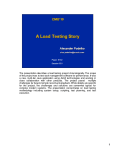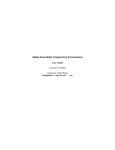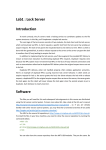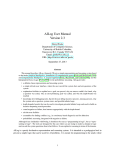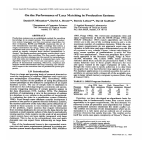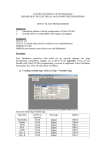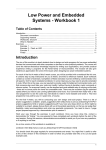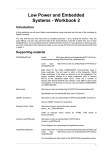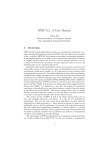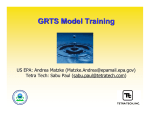Download Knowledge Representation and Reasoning Prolog and AILog
Transcript
Knowledge Representation and Reasoning
Prolog and AILog Practical 2012 – 2013
Exercises
Peter Lucas
Institute for Computing and Information Sciences (iCIS)
Radboud University Nijmegen
Contents
1 Learning outcomes
3
2 AI,
2.1
2.2
2.3
programming and representation
Symbol manipulation . . . . . . . . . . . . . . . . . . . . . . . . . . . . . . . .
Characteristics of PROLOG . . . . . . . . . . . . . . . . . . . . . . . . . . . .
AILog . . . . . . . . . . . . . . . . . . . . . . . . . . . . . . . . . . . . . . . .
3
3
4
5
3 Introductory remarks about PROLOG
3.1 PROLOG under Linux and Windows . . . . . . . . . . . . . . . . . . . . . . .
3.2 PROLOG programs . . . . . . . . . . . . . . . . . . . . . . . . . . . . . . . .
6
6
7
4 PROLOG exercises
4.1 Meet The Dutch Royal Family: facts, queries and
4.2 Lists and recursion . . . . . . . . . . . . . . . . .
4.3 Unification and matching . . . . . . . . . . . . .
4.4 Backtracking . . . . . . . . . . . . . . . . . . . .
4.5 Tracing and spying . . . . . . . . . . . . . . . . .
4.6 Variation of input-output parameters . . . . . . .
4.7 The order of clauses and conditions . . . . . . . .
4.8 Fail and cut . . . . . . . . . . . . . . . . . . . . .
4.9 A finite automaton . . . . . . . . . . . . . . . . .
4.10 Sorting . . . . . . . . . . . . . . . . . . . . . . . .
4.11 A relational database in PROLOG . . . . . . . .
4.12 Natural language processing . . . . . . . . . . . .
5 AILog exercises
5.1 AILog representation
5.2 Using AILog . . . .
5.3 Explanation facilities
5.4 User interaction . . .
.
.
.
.
.
.
.
.
.
.
.
.
.
.
.
.
.
.
.
.
.
.
.
.
.
.
.
.
.
.
.
.
.
.
.
.
1
.
.
.
.
.
.
.
.
.
.
.
.
.
.
.
.
.
.
.
.
.
.
.
.
.
.
.
.
rules .
. . . .
. . . .
. . . .
. . . .
. . . .
. . . .
. . . .
. . . .
. . . .
. . . .
. . . .
.
.
.
.
.
.
.
.
.
.
.
.
.
.
.
.
.
.
.
.
.
.
.
.
.
.
.
.
.
.
.
.
.
.
.
.
.
.
.
.
.
.
.
.
.
.
.
.
.
.
.
.
.
.
.
.
.
.
.
.
.
.
.
.
.
.
.
.
.
.
.
.
.
.
.
.
.
.
.
.
.
.
.
.
.
.
.
.
.
.
.
.
.
.
.
.
.
.
.
.
.
.
.
.
.
.
.
.
.
.
.
.
.
.
.
.
.
.
.
.
.
.
.
.
.
.
.
.
.
.
.
.
.
.
.
.
.
.
.
.
.
.
.
.
.
.
.
.
.
.
.
.
.
.
.
.
.
.
.
.
.
.
.
.
.
.
.
.
.
.
.
.
.
.
.
.
.
.
.
.
.
.
.
.
.
.
.
.
.
.
.
.
.
.
.
.
.
.
.
.
.
.
.
.
8
8
10
11
13
13
16
16
18
18
20
20
24
.
.
.
.
24
24
25
26
26
5.5
Model-based and probabilistic reasoning . . . . . . . . . . . . . . . . . . . . .
2
27
1
Learning outcomes
This Prolog and AILog practical offers you the opportunity to familiarise yourself with
the basic principles of the programming language Prolog and principles behind knowledge
representation and reasoning systems. In the practical you will learn:
• About the role and place of Prolog in the area of Artificial Intelligence (AI), and in
programming-language research more in general (See Section 2);
• The basic principles of Prolog by doing a number of exercises, described in Section 4
– the results you obtain for the two ⋆-marked exercises should be discussed with the
lecturer;
• How to use AILog.
• To use AILog reasoning systems on your own, by making the assignments which will
be distributed to you later in the course.
We will use SWI-Prolog, a good Prolog interpreter and compiler available in the public
domain.1 SWI-Prolog is very close to standard Prolog; the examples in this practical
manual are therefore based on SWI-Prolog.
A good book to learn programming in Prolog in the context of AI is I. Bratko, PROLOG Programming for Artificial Intelligence, 3rd ed, Addison-Wesley, Harlow, 2001 (earlier
editions are also useful), but there are many other good books about Prolog. There is an
AILog manual available on the website and blackboard. The material made available in the
course will be sufficient for you to complete the course successfully.
2
AI, programming and representation
2.1
Symbol manipulation
AI programs can be written in any decent, sufficiently expressive programming language,
including typical imperative programming languages such as C, C++, and Java. However,
many developers prefer to use programming languages such as Prolog and Lisp. Both
languages have a basis which cannot be traced back to the early ideas of computing as state
change of variables, as holds for the imperative languages, but instead to more abstract,
mathematical notions of computing. It is this formal foundation which explains why these
two languages are enormously expressive, much more than the imperative languages. As a
consequence, it is straightforward to create and manipulate complex data structures in these
languages, which is not only convenient but really essential for AI, as AI people tend to solve
complicated problems. Although much of what will be said in this introduction also holds for
Lisp, we will not pay further attention to this latter programming language. In general, Lisp
is not as closely linked to research on knowledge representation and reasoning as Prolog.
This is the main reason why Prolog has been selected for the course.
Prolog is frequently used for the development of interpreters of particular (formal) languages, such as other programming languages, algebraic or logical languages, and knowledgerepresentation languages in general. Languages are defined in terms of preserved (key)words,
1
See http://www.swi-prolog.org; there are free SWI-Prolog systems available for Linux, Mac OS, and
Windows.
3
i.e. symbolic names with a fixed meaning. In Java, for instance, the keywords class, public,
super are used. It is rather straightforward to develop a Prolog program that is able to
identify such keywords, and to interpreter these keywords in their correct semantic context.
Of course, this does not mean that it is not possible to develop such interpreters in imperative
languages, but almost all necessary facilities to do so are already included in any Prolog
system and really constitute the core of the language. Compare this to the situation in imperative programming languages, where one needs to resort to preprocessors and class libraries,
making it often far from easy to understand what is happening. In other words, the level of
abstraction offered by Prolog is much closer to the actual problem one is trying to solve
than to the machine or software environment being used. Using abstraction is preferred by
most people when developing a program for an actual problem, as it means: to ignore as
many irrelevant details as possible, and to focus on the problem issues that really matter.
When you are sufficiently versed in Prolog, the languages allows you to develop significant
programs with only limited effort.
Although Prolog and AI are often mentioned in one phrase, this does not mean that
Prolog is only suitable for the development of AI programs. In fact, the language has
and is being used as a vehicle for database, programming language, medical informatics and
bioinformatics research. And finally, the language is used by many people simply to solve
a problem they have to deal with, resulting in systems that from the user’s point of view
are indistinguishable from other systems, as in particular commercial Prolog systems offer
extra language facilities to develop attractive GUIs.2
2.2
Characteristics of PROLOG
There are a number of reasons why Prolog is so suitable for the development of advanced
software systems:
• Logic programming. Prolog is a logical language; the meaning of a significant fraction of the Prolog language can be completely described and understood in terms
of the Horn subset of first-order predicate logica (Horn-clause logic). So, this is the
mathematical foundation of the language, explaining its expressiveness.
• A single data structure as the foundation of the language. Prolog offers the term as
the basic data structure to implement any other data structure (lists, arrays, trees,
records, queues, etc.). The entire language is tailored to the manipulation of terms.
• Simple syntax. The syntax of Prolog is much simpler than that of the imperative
programming languages. A Prolog program is actually from a syntactical point of
view simply a sequence of terms. For example, the following Prolog program
p(X) :- q(X).
corresponds to the term :-(p(X),q(X)). Whereas the definition of the formal syntax
of a language such as Java or Pascal requires many pages, Prolog’s syntax can be
described in a few lines. Finally, the syntax of data is exactly the same as the syntax
of programs!
2
SWI-Prolog offers a special object-oriented library for GUI development called XPCE. This is not covered
in this practical, however.
4
• Program–data equivalence. Since in Prolog, programs and data conform to the same
syntax, it is straightforward to interpret programs as data of other programs, and also to
take data as programs. This feature is of course very handy when developing interpreters
for languages.
• Weak typing. Types of variables in Prolog do not have to be declared explicitly.
Whereas in C or Java, the type of any object (for example int, real, char) needs to
be known before the compiler is able to compile the program, the type of a variable
in Prolog only becomes relevant when particular operations are performed on the
variable. This so-called weak typing of program objects has as a major advantage that
program design decisions can be postponed to the very last moment. This eases the
programmer’s task. However, weak typing not only comes with advantages, as it may
make finding program bugs more difficult. Expert programmers are usually able to cope
with these problems, while in addition most Prolog systems come with tools for the
analysis of programs which may be equally useful for finding bugs.
• Incremental program development. Normally, a C or Java program needs to be developed
almost fully before it can be executed. A Prolog program can be developed and
tested incrementally. Instead of generating a new executable, only the new program
fragments need to be interpreted or compiled. It is even possible to modify a program
during its execution. This offers the programmer the possibility of incremental program
development, a very powerful and flexible approach to program development. It is
mostly used in research environments and in the context of prototyping.
• Extensibility. A Prolog system can be extended and modified. It is even possible to
modify the Prolog language, and to adapt both its syntax and semantics to the needs.
For example, although Prolog is not an object-oriented language, it can be extended
quite easily into an object-oriented language, including primitives for inheritance and
message passing. Compare this to the task of modifying a Java interpreter into a
Prolog compiler, something which would require an almost complete redesign and
re-implementation of the original Java system.
2.3
AILog
Rather than a programming language such as Prolog, AILog is a knowledge-representation
and reasoning system built on top of Prolog. The language one can use in AILog for
modelling, however, is very similar to that of Prolog. The main facilities offered by AILog
are:
• a knowledge-representation and reasoning system that supports different forms of logical
and probabilistic reasoning;
• an ask-tell interface that allow users to communicate with AILog;
• explanation facilities allowing users to explore why and how the system did, or did not,
derive a particular fact.
5
3
Introductory remarks about PROLOG
By means of a number of small Prolog programs, which can be found in the directory
/vol/practica/IS/Prolog and as a zip file on the course’s website3 , the most important
features of the Prolog language will be studied in this practical. The programs are available
in the following files:
exercise0.pl
exercise1.pl
exercise2.pl
exercise3.pl
exercise4.pl
exercise5.pl
exercise6.pl
exercise7.pl
exercise8.pl
exercise9.pl
(facts, queries and rules)
(lists and recursion)
(backtracking)
(parameters)
(order of clauses)
(fail and cut)
(finite automaton)
(sorting)
(relational database)
(natural language processing)
Copy these files to your own directory.
3.1
PROLOG under Linux and Windows
Under Linux and Windows SWI-Prolog is activated and reads in a Prolog program by
clicking on the program (which should have the .pl extension in order to be recognised).
One can quit the system by the command:
halt.
The SWI-Prolog system can also be activated under Linux by typing in:
pl
A program stored in a file, for example the file exercise0.pl, can be read into the Prolog
interpreter by typing (assuming you are in the directory where the file resides):
?- [exercise0].
This is called consulting a file; the symbol ?- is the system prompt. If a file has the
extension .pl, the extension need not be typed in, as the file name is automatically completed. Hence, normally files with extension .pl indicate Prolog programs (this convention
is unfortunately also used for Perl programs). If one prefers to use another extension than
.pl, the full name of the file in between single quotes must be supplied. For example,
?- [’prog.pro’].
causes the program in the file prog.pro to be loaded. The above also works for the Windows
environment.
It is also possible, although not very convenient, to type in a program in the Prolog
system itself. This is accomplished by ‘consulting’ the file user.
3
http://www.cs.ru.nl/∼peterl/teaching/KeR/
6
?- [user].
|
The file user represents your keyboard. Its input can be terminated by <cntrl>d. In most
cases, it is better to use an editor, such as emacs or some other editor, as these offer editing
possibility far superior to the user interface. There is normally a special Prolog mode
available for emacs users. Note that a program that has been typed in at user is lost when
leaving the system.
In the next sections, it is assumed that the meaning of most Prolog predicates is known.
The handout ‘Introduction to Prolog’ and any book about Prolog contain descriptions of
the standard predicates.
3.2
PROLOG programs
A Prolog program consists of a sequence of clauses; a Prolog clause is either:
• a fact,
• a query or goal, or
• a rule.
Either or all of these may be empty (so, the simplest Prolog program is nothing!). Let us
see what response we get from Prolog when trying to execute the empty program:
knuth-1 > pl
Welcome to SWI-Prolog (Multi-threaded, Version 5.6.35)
Copyright (c) 1990-2007 University of Amsterdam.
SWI-Prolog comes with ABSOLUTELY NO WARRANTY. This is free software,
and you are welcome to redistribute it under certain conditions.
Please visit http://www.swi-prolog.org for details.
For help, use ?- help(Topic). or ?- apropos(Word).
?- nothing.
[WARNING: Undefined predicate: ‘nothing/0’]
No
?The Prolog prompt ?- basically asks the user to type in a query. What is typed in, is
shown in italised, bold face, and includes the terminating dot. Prolog issues a warning, as
it does not recogise the query ?- nothing. However, this warning is not part of Prolog,
but a feature of SWI-Prolog to help in program debugging. The response of Prolog to
this empty program is No, which means that this program has failed.4
Above, we have only employed the declarative terminology of Prolog, which views Prolog as a logical language. There also exists a procedural terminology, where facts and rules
are called procedure (entries), and queries or goals are called (procedure) calls. In addition,
4
Deep Philosophers will note that we have not really studied the effects of the empty program, as the tested
program actually consisted of a single clause: the query ?- nothing. When we type in nothing at all we get
the real response to the empty program from Prolog, which is ?-. So, this is the real nothing!
7
we speak of the head and the body of a clause, which again is terminology that derives from
the procedural interpretation of Prolog. Hence, using this terminology, a Prolog clause is
defined as:
clause ::= head :- body.
where body is defined as:
body
::= disjunction,. . .,disjunction
disjunction ::= condition | (condition; · · · ;condition)
However, even when using the procedural terminology, it is difficult to ignore the logical basis
of Prolog, as the comma ‘,’ has the meaning of conjunction ∧ (and), and the semicolon ‘;’
has the meaning of disjunction ∨ (or). We will use both terminologies in this practical to
conform to the practice in the Prolog and logic programming community.
4
PROLOG exercises
It is assumed you have copied the files to your directory as indicated in Section 3.
4.1
Meet The Dutch Royal Family: facts, queries and rules
Consider the following facts concerning the Dutch Royal Family. This family is so large, that
I declare myself unable to unravel the details of the relationships among the members of the
family, hence only the most obvious facts have been represented (but you are invited to exend
the program!):
% The facts about the Dutch Royal Family
mother(wilhelmina,juliana).
mother(juliana,beatrix).
mother(juliana,christina).
mother(juliana,irene).
mother(juliana,margriet).
mother(beatrix,friso).
mother(beatrix,alexander).
mother(beatrix,constantijn).
mother(emma,wilhelmina).
father(hendrik,juliana).
father(bernard,beatrix).
father(bernard,christina).
father(bernard,irene).
father(bernard,margriet).
father(claus,friso).
father(claus,alexander).
father(claus,constantijn).
father(willem,wilhelmina).
8
queen(beatrix).
queen(juliana).
queen(wilhelmina).
queen(emma).
king(willem).
In these facts, mother and father are called predicates or functors; elements such as beatrix
are called constants or atoms (an atom is a constant that is not a number). The meaning
of the fact mother(juliana, beatrix) is that Princess Juliana, the previous queen, is the
mother of Queen Beatrix, the present queen. The meanings of the other mother and father
facts are similar.
Now, if you are either a mother or father of a person, you are also seen as the parent of
that person. This is a general rule, which even applies to members of the Royal Family. A
rule, however, which uniquely applies to the Royal family is the one which defines kings and
queens as rulers. These two principles can be formulated as four Prolog rules:
parent(X, Y) :- mother(X,Y).
parent(X, Y) :- father(X,Y).
ruler(X) :- queen(X).
ruler(X) :- king(X).
Note that the bodies of these rules consist of a single condition. X and Y in these rules are
variables. They seem similar to atoms, but are required to start with an upper-case letter
or underscore. Variables can be bound or instantiated to constants or other variables by a
process called matching or unification (see below, Section 4.3).
Surely, one of the most popular questions asked by American tourists visiting the Netherlands is who predecesses who.5 Now, this can be easily formulated into another two rules:
predecessor(X,Y) :parent(X,Y),
ruler(X),
ruler(Y).
predecessor(X,Y) :ruler(X),
parent(X,Z),
predecessor(Z,Y).
Note that these rules have multiple conditions constituting the body that must be satisfied
in order for a rule to be satisfied. Also note the indentation of the body in comparison to the
head; it makes Prolog programs more readable.
The facts and rules above constitute a Prolog program. The clauses of a Prolog
program are loaded into a part of the Prolog system called the Prolog database, which
is rather confusing terminology, as a Prolog system is not a database system. It can be
invoked by means of queries or goals.
◮ The complete Prolog program is included in the file exercise0.pl. Consult this file, and
query the program. If the Prolog system returns with a response, you can enter a semicolon
5
Another one is how much their possessions are worth.
9
‘;’, and Prolog will give an alternative solution. If you simply enter <return > Prolog
stops looking for alternatives. For example, enter the following queries:
?- parent(beatrix,alexander).
?- parent(beatrix,X).
?- parent(beatrix,emma).
?- parent(X,Y), ruler(Y).
?- predecessor(X,beatrix).
Try to understand the answers returned by Prolog by studying the program. (But be careful
not to turn into a royalist!)
4.2
Lists and recursion
The list is one of the most popular data structures in Prolog. A list is simply a sequence
of elements, separated by commas and embraced by brackets:
[e1 , e2 ,. . ., en ]
Each element ei , 1 ≤ i ≤ n, n ≥ 0, can be an arbitrary Prolog term, including a list.
Consider now the following list:
[a,b,c,d]
It consists of four elements, where each element in this case is an atom (recall that this is a
constant symbol that is not a number).
The following list consists of three elements,
[e1 ,e2 ,e3 ]
but is actually defined as
[e1 |[e2 |[e3 |[]]]]
where e1 is called the head of the list, and [e2 |[e3 |[]]] is called its tail. Thus, as you already
suspected, a list is a term of which the functor (from a logical point of view, the functor is
now not a predicate, but a function symbol) has two arguments: the head and the tail. A list
containing a single element [e] is really the following term: [e|[]]. A simplified notation
as [e1 ,e2 ,e3 ] is called syntactic sugar, as it makes dealing with lists easier. (Syntactic sugar
makes your programs more tasty!)
Note that the following five lists
[a,b,c]
[a|[b,c]]
[a|[b|[c]]]
[a|[b|[c|[]]]]
[a,b|[c]]
10
are different representations of what essentially is the same list.
The handout ‘Introduction to Prolog’ includes an example of a simple Prolog program. This program identifies whether a particular element is a member of a set of elements,
represented as a list. The following clauses are given (the predicate ‘member’ was replaced by
‘element’, as ‘member’ is already included in most Prolog systems):
/*1*/ element(X,[X|_]).
/*2*/ element(X,[_|Y]) :element(X,Y).
Examples of queries to this program are:
?- element(d,[a,b,c,d,e,f]).
Note that the predicate element both occurs in the body of clause 2 and also in its head.
Hence, this is an example of a recursive rule. In fact, you have seen recursion before when we
considered Dutch royalty.
◮ The two Prolog clauses are included in the file exercise1.pl. Consult this file, and query
the system. For example, try:
?- element(a,[b,a,c]).
?- element(d,[b,a,c]).
?- element(X,[a,b,c,d]).
Again, try to understand what is happening.
4.3
Unification and matching
An important mechanism underlying every Prolog-interpreter is the unification of terms.
Unification basically attempts to make two terms equal by substituting appropriate terms for
the variables occurring in the two terms. In all cases, the so called most general unifier (mgu)
is determined. A term can both be a condition and a head of a clause, but also a structure
deeply nested into a condition or head.
To answer a query, the Prolog interpreter starts with the first condition in the query,
taking it as a procedure call. The Prolog database is subsequently searched for a suitable
entry to the called procedure; the search starts with the first clause in the database, and
continues until a clause has been found which has a head that can be matched with the
procedure call. A match between a head and a procedure call is obtained, if there exists a
substitution for the variables occurring both in the head and in the procedure call, such that
the two become (syntactically) equal after the substitution has been applied to them. Such
a match exists:
• if the head and the procedure call contain the same predicate, and
• if the terms in corresponding argument positions after substitution of the variables are
equal; one then also speaks of a match for argument positions.
11
Applying a substitution to a variable is called instantiating or binding the variable to a term.
For example, the query:
?- parent(X,Y).
yields the following instantiations given the program in the file exercise0.pl discussed in
Section 4.1:
X = wilhelmina
Y = juliana
A user can force unifying two terms by means of the infix predicate (functor) ‘=’. As an
example, consider the following two terms:
p(X,a,f(Y,g(b))) and
p(f(b),a,f(c,g(b)))
The following query
?- p(X,a,f(Y,g(b))) = p(f(b),a,f(c,g(b))).
leads to the following substitutions:
X = f(b)
Y = c
because:
• the two functors of the two terms are equal (both p);
• to make the first arguments syntactically equal, the term f(b) has to be substituted for
the variable X;
• the second arguments are already equal;
• in order to make the third arguments equal, we have to unify the terms f(Y,g(b)) and
f(c,g(b)). The functors of these two arguments are already equal, as are the second
arguments of the terms. If we substitute the term c for the variable Y, the second
arguments will also have become equal.
If two terms have been successfully unified, it is said that a match has been found; otherwise,
there is no match.
◮ Investigate whether the following pairs of terms match, and, if they do, which substitutions
do make them equal?
p(f(X,g(b)),Y) and p(f(h(q),Y),g(b))
p(X,a,g(X)) and p(f(b),a,g(b))
[[a]|[b]] and [X,Y]
p(X,f(X)) and p(Y,Y)
It is not possible to find a match for the last pair of terms. Yet, Prolog is not able to
recognise this fact. First, the matching algorithm substitutes Y for X:
12
X = Y
The second arguments of p would become equal if
Y = f(X)
This creates a cyclic binding between the variables X and Y; hence, it is not possible to unify
these two terms. Many Prolog interpreters, however, are not able to detect this fact, and get
stuck in an infinite loop. What is missing in the implementation of the unification algorithm
is known as the occur-check. It is often left out for efficiency reasons. To make a distinction
between unification that includes the occur-check, and unification without, the latter is often
called matching.
4.4
Backtracking
Backtracking is a mechanism in Prolog that is offered to systematically search for solutions
of a problem specified in terms of Prolog clauses. A particular Prolog specification may
have more than one solution, and Prolog normally tries to find one of those. When it is
not possible to prove a subgoal given an already partially determined solution to a problem,
Prolog does undo all substitutions which were made to reach this subgoal, and alternative
substitutions are tried.
The search space that is examined by the Prolog system has the form of a tree. More
insight into the structure of this space is obtained by a Prolog program that itself defines
a tree data structure:
/*1*/
/*2*/
/*3*/
/*4*/
branch(a,b).
branch(a,c).
branch(c,d).
branch(c,e).
/*5*/ path(X,X).
/*6*/ path(X,Y) :branch(X,Z),
path(Z,Y).
◮ Load the file exercise2.pl into the Prolog interpreter, and pose the following queries to the
Prolog database. Check the answers returned by Prolog.
?- path(a,d).
Figure 1 shows the tree corresponding to the program. This figure is useful for understanding
the execution steps carried out by the Prolog interpreter. In the next section, we shall
consider a number of facilities offered by most Prolog systems which assist in debugging
programs.
4.5
Tracing and spying
Prolog systems offer a number of facilities to ‘debug’ a program. Two of those techniques
will be considered in this section. They are probably quite useful when working through the
remainder of the exercises. A program can be debugged by using:
13
a
b
c
d
e
Figure 1: A binary tree.
• the trace predicate, which makes sure that every execution step is shown;
• selective tracing of a program, which is made possible by so-called spy points. This is
accomplished by the spy predicate.
By means of an example, we illustrate below how debugging with those two facilities works
in practice.
After consulting a program, the trace facility can be switched on by the query:
?- trace.
For example, if after loading the file exercise2.pl as described in Section 4.4 into Prolog,
and after switching on the trace facility, and querying Prolog:
| ?- trace.
Yes
| ?- path(a,e).
the following is shown:
Call:
(
7) path(a,e) ?
The question marks indicates that the user may enter an option, to change the behaviour of
the interpreter. A list of all possible options is obtained by entering the letter ‘h’. Each next
execution step is shown by entering <return >:
?- path(a,e).
Call: ( 7)
Call: ( 8)
Exit: ( 8)
Call: ( 8)
Call: ( 9)
Fail: ( 9)
Fail: ( 8)
Redo: ( 8)
Exit: ( 8)
Call: ( 8)
Call: ( 9)
path(a, e) ? creep
branch(a, _L155) ? creep
branch(a, b) ? creep
path(b, e) ? creep
branch(b, _L178) ? creep
branch(b, _L178) ? creep
path(b, e) ? creep
branch(a, _L155) ? creep
branch(a, c) ? creep
path(c, e) ? creep
branch(c, _L167) ? creep
14
Exit:
Call:
Call:
Fail:
Fail:
Redo:
Exit:
Call:
Exit:
Exit:
Exit:
( 9) branch(c, d) ? creep
( 9) path(d, e) ? creep
( 10) branch(d, _L190) ? creep
( 10) branch(d, _L190) ? creep
( 9) path(d, e) ? creep
( 9) branch(c, _L167) ? creep
( 9) branch(c, e) ? creep
( 9) path(e, e) ? creep
( 9) path(e, e) ? creep
( 8) path(c, e) ? creep
( 7) path(a, e) ? creep
Yes
?This information can be interpreted as follows. The number between parentheses represents
the recursion level of the call (7 as a starting level); Call is followed by the subgoal that
has to be proven; Exit indicates that the subgoal has been proven, en Fail indicates that
proving the subgoal failed. If the program, as a consequence of a failed subgoal, backtracks
to a previously considered subgoal, then this is indicated by Redo. Note that variables are
renamed to unique internal names, such as L155.
◮ The above program is available in the file exercise2.pl. Now, experiment with the trace
facility so that you understand it thoroughly.
Switch off debug mode by nodebug.
Selective information of the execution is obtained by means of spy points. A spy point is
indicated as follows:
spy(<specification >)
where <specification > is the name of a predicate or a name follows by the arity (number
of arguments) of the predicate. For example:
spy(path).
spy(branch/2).
A spy point can be removed by the predicate: nospy:
nospy(path).
nospy(branch/2).
The structure of the information generated by the Prolog interpreter in the case of spy
points is almost identical to the information that is generated by using trace.
◮ Experiment with spy points using the tree search algorithm.
15
4.6
Variation of input-output parameters
An argument of a query can both function as an input and an output parameter, depending on
the context of the query. This ensures that a program can be used for sometimes completely
different, even opposite purposes, like construction and analysis. Consider the the following
program, which is available in the file exercise3.pl:6
conc([],L,L).
conc([X|L1],L2,[X|L3]) :conc(L1,L2,L3).
This program can be used to concatenate two lists, but, in fact, it can be used as well to split
up a list into its parts.
◮ Check the statement above by consulting the file exercise3.pl,; ask the following questions to
the Prolog interpreter (when the interpreter returns with a response, enter ‘;’ in order to
enforce backtracking, so that Prolog will attempt to find alternative solutions.
?- conc(X,Y,[a,b,c,d,e]).
?- conc([a,b],[c,d],X).
The fact that it is possible to use the same program for such different purposes follows from
the fact that Prolog is essentially a declarative language based on a mathematical (logical)
notion of computing.
4.7
The order of clauses and conditions
According to the principle of logic programming, neither the order of Prolog clauses nor the
order of conditions in the bodies of Prolog clauses really matters. However, as a consequence
of its fixed backtracking scheme this is not entirely the case for Prolog. For example, it is
possible that there does exist a solution to a problem according to the logical interpretation of
a Prolog program, whereas Prolog is not able to find it. As a consequence, any Prolog
programmer requires a good understanding of where and when order in and among clauses
matters, and when not.
The program we are going to study in order to get a better understanding of the order
issues in Prolog is available in the file exercise4.pl.
The following facts concern the relation parent(X,Y), which expresses that X is a parent
of Y:
parent(pam,bob).
parent(tom,bob).
parent(tom,liz).
parent(bob,ann).
parent(bob,pat).
parent(pat,jim).
6
The predicate conc is known in Prolog as append, but as this is often a built-in, we have renamed append
to conc.
16
◮ Pose a number of queries to the program. For example, how do you find out what the names
are of Tom’s children? And, who are Bob’s parents?
The following two clauses recursively define that X is a predecessor of Z, predecessor1(X,Z),
if X is a parent of Z or if there is a person Y, such that X is a parent of Y and Y is a predecessor
of Z.
/*1*/ predecessor1(X,Z) :parent(X,Z).
/*2*/ predecessor1(X,Z) :parent(X,Y),
predecessor1(Y,Z).
◮ Query this program, and find out how Prolog is able to give answers to your queries using
Prolog’s debug facilities.
There are three other declaratively correct specifications of the problem possible, which only
differ with respect to order of clauses and conditions. Firstly, the order of the two clauses can
be reversed. This results in the following program:
/*3*/ predecessor2(X,Z) :parent(X,Y),
predecessor2(Y,Z).
/*4*/ predecessor2(X,Z) :parent(X,Z).
◮ Ask again a number of queries, and compare the results with those obtained for the first
program. Can you explain the differences?
It is also possible to interchange the two conditions in the second clause, yielding the following
program:
/*5*/ predecessor3(X,Z) :parent(X,Z).
/*6*/ predecessor3(X,Z) :predecessor3(X,Y),
parent(Y,Z).
◮ Which queries will this program be unable to answer?
Finally, we can interchange clause 1 as well interchange both conditions in clause 2¿ The
following result is then obtained:
/*7*/ predecessor4(X,Z) :predecessor4(X,Y),
parent(Y,Z).
/*8*/ predecessor4(X,Z) :parent(X,Z).
◮ Investigate which queries cannot be answered by this program, and try to explain why they
cannot.
17
4.8
Fail and cut
Some of the predicates which Prolog offers can be used to control Prolog’s execution
method in particular ways. Two important ones are the fail and the cut predicate. If the fail
predicate is used as a condition, then this condition will always fail, regardless of anything
else (hence, of course, the name of this predicate). Usually, the fail predicate is used to
enforce backtracking in order to obtain or consider alternative solutions for a problem. Now,
consider the program given in the file exercise5.pl:
element1(X,[X|_]).
element1(X,[_|Y]) :element1(X,Y).
all_elements1(L) :element1(X,L),
write(X),
nl,
fail.
all_elements1(_).
By means of the clauses all elements1, the elements of a list L are printed one by one. Note
that the element1 predicate is called in all elements1.
◮ Experiment with the all elements1 program. Do you understand why there is also a second
all elements1 clause included?
Next, the effects of the cut predicate on program execution are considered. Whereas the fail
predicate enforces backtracking, the cut tries to prevent it. So, these two predicates are more
or less complementary. Consider the following use of the cut:
element2(X,[X|_]) :- !.
element2(X,[_|Y]) :element2(X,Y).
all_elements2(L) :element2(X,L),
write(X),
nl,
fail.
all_elements2(_).
◮ Study the difference in behaviour between all elements1 and all elements2, and try to
explain this difference.
4.9
A finite automaton
A finite automaton is a mathematical object, which is used to determine whether a particular
string of symbols has the right structure or syntax. Finite automata are for example used to
build compilers of programming languages, but also to build simulators.
18
An automaton is always in a one of a given set of states. One of those states is the initial
state, another one is the final state. By examining one of the symbols in the given string,
the automaton may go to another state, as specified by means of a transition function. If the
automaton is in the final state after processing the string, it is said that the string is accepted;
otherwise, it is said that the string has been rejected.
For the automaton that is considered here, the following set is defined:
S = {s1 , s2 , s3 , s4 }
Assume that s1 is the initial state and that s3 is the final state. The transition function is
defined by means of the following productions:
s1
s1
s1
s2
s3
s4
→
→
→
→
→
→
as1
as2
bs1
bs3
bs4
s3
The last transition is a silent transition: the automaton simply moves to another state without
reading a symbol.
The transition function can be easily specified in Prolog; for example the predicate
transition(s1,c,s2) says that the automaton changes from state s1 to s2 after reading the
symbol ‘c’. The condition silent(s1,s2) represents a silent transition. The fact that s3 is a
silent transition is indicated by the predicate end. The transition function as defined above
can therefore be defined in Prolog as follows:
end(s3).
transition(s1,a,s1).
transition(s1,a,s2).
transition(s1,b,s1).
transition(s2,b,s3).
transition(s3,b,s4).
silent(s4,s3).
The following rules investigate whether a string is either or not accepted:
accept(S,[]) :end(S).
accept(S,[X|Rest]) :transition(S,X,S1),
accept(S1,Rest).
accept(S,String) :silent(S,S1),
accept(S1,String).
⋆ (P.1) Investigate using this program which input string with 3 and 4 symbols are accepted by
the finite automaton. The program is included in the file exercise6.pl. The first argument
of accept is the initial state; the second argument is a string, represented as a list of symbols.
19
4.10
Sorting
As you already know, there are quite a number of different algorithms for sorting elements
of a set (or multiset), assuming that a total order is defined on these elements. One of the
simplest is the well-known bubble sort algorithm. In the bubble sort, two successive elements
in a sequence of (here) numbers are examined. If they are in the right order, the algorithm
proceeds to the next pair; otherwise, the two numbers are interchanged, and the algorithm
proceeds by considering the next pair. This goes on until there are no elements left which
need to be interchanged. Both worst and average case time complexity of the bubble sort is
quadratic.
It is quite straightforward to express this algorithm in terms of a Prolog program.
Assuming that a set of elements is represented as a list, one possible program is:
bubsort(L,S) :conc(X,[A,B|Y],L),
B < A,
conc(X,[B,A|Y],M),
!,
bubsort(M,S).
bubsort(L,L).
conc([],L,L).
conc([H|T],L,[H|V]) :conc(T,L,V).
◮ Investigate the workings of this program; it is available in file exercise7.pl.
4.11
A relational database in PROLOG
Basically, Prolog programs are about defining relation among objects in a domain. As
storing data as instances of relations is the essential feature, you are probably not surprised
to learn the Prolog is very good in performing the sort of operations on data, which many
people normally associate with a relational database management system.
For example, consider salary(scale,amount) which is the sort of relation defined in a
relational data model. Recall that scale and amount are referred to as attributes, whereas
specific instances of this relation are called tuples. A relational database contains tuples
defined according to the data model. Retrieving data stored in the database according to
particular constraints on the attributes is called querying the database.
The file exercise8.pl includes an example of a database, with the following data model
(Note that the data model is really implicit in this case, which is because we simply make use
of standard Prolog facilities without implementing anything extra):
• employee(name,department number ,scale)
• department(department number,name department)
• salary(scale,amount)
The database (Prolog database in this case) included the following tuples (facts), again
included in exercise8.pl:
20
employee(mcardon,1,5).
employee(treeman,2,3).
employee(chapman,1,2).
employee(claessen,4,1).
employee(petersen,5,8).
employee(cohn,1,7).
employee(duffy,1,9).
department(1,board).
department(2,human_resources).
department(3,production).
department(4,technical_services).
department(5,administration).
salary(1,1000).
salary(2,1500).
salary(3,2000).
salary(4,2500).
salary(5,3000).
salary(6,3500).
salary(7,4000).
salary(8,4500).
salary(9,5000).
Relational database theory offers a number of useful operations which can be carried out to
extract information from a given database. The result of these operations is a new relation,
i.e. a new set of tuples. Typical examples of such database operations are selection, projection and the join. Below we shall discuss simple Prolog implementations of the selection,
projection and join, just to give you an impression of how such programs may look like. The
implementation of a more complete relational database package would, of course, be more
involving than would be realistic for this practical. We will make use of an Sql-like notation
(as you know, Sql is the most popular query language in relational databases).
The purpose of a selection is to request tuples which fulfil certain conditions with respect
to their attribute values. Consider, for example, the query: ‘Select all employees from department 1 with a salary higher than scale 2.’ In Sql-like syntax, this could be stated as
follows:
SELECT * FROM employee WHERE department_number = 1 AND
scale > 2.
Expressed as a Prolog query, the purpose is to select tuples satisfying the following condition:
?- employee(Name,Department_N,Scale),
Department_N = 1,Scale > 2.
◮ Consult the file exercise8.pl and enter the Prolog query given above.
The following output is produced:
21
Name = mcardon
Department_N = 1
Scale = 5.
By entering the ‘;’ operator (the logical ∨ connective) is it again possible to find out whether
there are any alternative solutions, as Prolog will then backtrack, and will check whether
there are any other employees satisfying the conditions. Note that, in fact, we have not yet
produced a functionally complete implementation of the selection operator, as only a single
tuple is selected from the database, but we are nearly there. Recall the trick we considered
before, where we made use of the fail predicate in order to enforce backtracking. Here we
use this trick again. This gives us the following implementation of the selection operator:
selection(X,Y) :call(X),
call(Y),
write(X),
nl,
fail.
selection(_,_).
The predicate call generates a subgoal determined by the binding of its variable argument.
It is assumed that the first argument of selection represents the relation from which tuples
are to be selected; the second argument contains the set of selection conditions which should
be satisfied by the selected tuples. For example, all employees in department 1 with a salary
scale higher than 2 are selected by the following query:
?- selection(employee(Name, Department_N, Scale),
(Departments_N = 1,Scale > 2)).
◮ Design a Prolog query to select those employees who earn between £3,000 and £4,500 per
month? Also select all employees who are in salary scale 1, and working in department 1.
The projection operator in relational database theory is used to select some attributes (or
columns in the corresponding tables) from a relation. For example, the query ‘give for all
employees only the name and scale’, in Sql-like notation:
SELECT name,scale FROM employee.
However, the Prolog query does again give rise to the selection of a single tuple:
?- employee(Name,_,Scale).
But, as you already know, by using the ‘;’ operator the other tuples can be selected as well.
◮ Type in the above-given Prolog query. Can you explain why we use here the anonymous
variable ?
As you may have guessed, the resulting Prolog implementation of the projection operator
is quite similar to the implementation of the selection operator discussed above.
22
projection(X,Y) :call(X),
write(Y),
nl,
fail.
projection(_,_).
The first argument of projection should be the relation that is being projected; the second
argument lists the attributes on which the relationship must be projected. For example, name
and scale of employees are obtained as follows:
?- projection(employee(Name, Department_N, Scale),
(Name, Scale)).
Note that this is still not a complete implementation of the projection, as the resulting
relation may not include doubles. As incorporating this in the program as well would make
it quite a bit more complicated, hardly worth the effort for small databases, we leave the
program as it is.
◮ Experiment with the projection program until you fully understand how it works.
It is now quite straightforward to combine selection and projection. This would imply not
only specifying the attributes used in projecting a relation, but also giving the conditions on
the attributes which need to be satisfied by the selected tuples. Consider, for example, the
following query ‘Print the name and scale of those employees in department 1, with a salary
higher than scale 2’. In Sql-like notation:
SELECT name,scale FROM employee WHERE department_number = 1
AND scale > 2.
◮ Define yourself the predicate sel pro which is meant to combine selection and projection.
The final database operation which we will consider is the join. The join simply merges
tuples in relations based on a join condition. Suppose that one would like to obtain a list of
employees, with for every employee the salary included. For this purpose, we need information
from two different relations: employee and salary. For every employee we need to find the
salary corresponding to the salary scale. Hence, the join condition in this case is equality of
tuples in the two relations concerning the attribute scale. In Sql-like notation:
JOIN employee WITH salary WHERE
employee.scale = salary.scale
The following two clauses offer an implementation of the join operator:
join(X,Y,Z) :call(X),
call(Y),
call(Z),
write(X),
write(Y),
nl,
fail.
join(_,_,_).
23
The first and second arguments represent relations; the third argument is used to specify join
conditions. For example:
?- join(employee(Name,Department_N,Scale1),
salary(Scale2,Amount),
(Scale1 = Scale2)).
will yield the requested result.
⋆ (P.2) Express in Prolog a join between the relations employee and department, and inspect
the result.
4.12
Natural language processing
From its inception, Prolog has been enormously popular with researchers in the field of
natural language processing. Due to its declarative nature, the language is both suitable for
the development of programs that analyse sentences as well as for language generation. In this
case, we only consider a very simplistic example of a program, as natural language processing
is a field in its own right, involving many special issues.
The following program is given in the file exercise9.pl:
sentence(X) :- noun_phrase(X,Y),
verb_phrase(Y,[]).
noun_phrase([X|Y],Y) :noun(X).
noun_phrase([X1,X2,X3|Y],Y) :article(X1),
adjective(X2),
noun(X3).
verb_phrase([X|Y],Z) :verb(X),
noun_phrase(Y,Z).
◮ Develop a small dictionary that can be used to generate sentences.
◮ Why are the predicate noun_phrase and verb_phrase supplied with a second argument? Is
this program also capable of generating sentences? We could also have made use of the conc
predicate in developing this program (see exercise3.pl). How would this have affected the
program?
5
5.1
AILog exercises
AILog representation
As Prolog, AILog supports Horn clauses. However, it is preferred to use in AILog a
syntax that slightly different from Prolog. A clause has to conform to the following syntax:
clause ::= head <- body.
24
In a body one is advised to use the ampersand ‘&’ for logical conjunction rather than the
comma ‘,’. This allows making a syntactic distinction between Prolog programs and AILog
representations, although AILog is also able to parse Prolog syntax.
5.2
Using AILog
First one needs to download the ailog2.pl Prolog program; program available at:
http://www.cs.ru.nl/∼peterl/teaching/KeR/AILog/ailog2.pl
The AILog user manual can be downloaded at:
http://www.cs.ru.nl/∼peterl/teaching/KeR/AILog/ailog man.pdf
Next, AILog must be loaded into Prolog:
?- [ailog2].
AILog Version 2.3.3. Copyright 2009, David Poole.
AILog comes with absolutely no warranty.
All inputs end with a period. Type "help." for help.
ailog:
One can load knowledge bases into AILog using the load command:
ailog: load ’example’.
However, it is also possible to communicate clauses to AILog manually by means of the asktell command interface. By means of the tell command, clauses are added to the knowledge
bases:
ailog: tell parent(X, Y) <- mother(X,Y).
ailog: tell mother(juliana,beatrix).
One can query the knowledge base by means of the ask command:
ailog: ask parent(X, Y).
Answer: parent(juliana, beatrix).
If one wishes to inspect the content of the knowledge base, the command listing can be
used:
ailog: listing.
parent(A, B) <- mother(A, B).
mother(juliana, beatrix).
ailog:
Note that the variable names X and Y are renamed.
◮ Compare the Prolog program exercise0.pl to the AILog knowledge base exercise10.ail.
What are the differences?
◮ Load the knowledge base exercise10.ail into AILog and inspect its content.
25
◮ Ask questions to the knowledge base, and compare the results to those obtained for exercise0.pl.
Do you notice differences?
You may have noticed that AILog does not go into infinite recursion; rather it used a
depth-bound to limited recursion. The used can increase the depth-bound interactively when
necessary.
5.3
Explanation facilities
The userinterface of AILog allows determining how a particular fact was derived, why a
particular fact was not derived, and why a particular fact was derived. This is done by the
commands: how, whynot, and why, respectively. Have a look at the following example:
ailog: ask predecessor(X,Y).
Answer: predecessor(emma, beatrix).
[ok,more,how,help]: how.
predecessor(emma, beatrix) <1: predecessor(wilhelmina, beatrix)
2: ruler(emma)
3: parent(emma, wilhelmina)
How? [Number,up,retry,ok,prompt,help]: 2.
ruler(emma) <1: queen(emma)
How? [Number,up,retry,ok,prompt,help]:
◮ Try to understand the way these commands work from the AILog user manual.
◮ Load the knowledge base exercise10.ail into AILog ask questions and experiment with the
explanation facilities.
5.4
User interaction
AILog also allows prompting users by means of the anskable build-in predicate. For example, by replacing
father(hendrik, juliana).
by
askable father(hendrik, juliana).
in the file exercise10.ail, one obtains the following behaviour:
ailog: ask predecessor(X,Y).
Is father(hendrik, juliana) true? [yes,no,unknown,why,help]: yes.
Answer: predecessor(emma, beatrix).
[ok,more,how,help]:
◮ Change one of the facts in the file exercise10.ail to askable, and see what happens when
you query the knowledge base.
26
5.5
Model-based and probabilistic reasoning
You will use AILog in assignments on model-based and probabilistic reasoning. Modelbased reasoning is done by making some of the atoms in the knowledge base assumable.
Probabilistic reasoning is done by adding probabilistic information to clauses. Consult the
AILog manual for details.
27



























